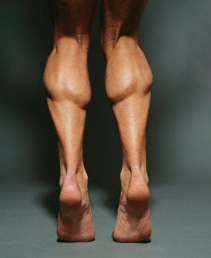Anatomy of a Calf Strain

Neither weekend warriors nor professional mixed martial artists are immune to a calf injury. Whether it’s due to the unstable surface of a training mat, or the repetitive explosive motions performed during a fight, all who train and compete are more vulnerable to sitting on the sidelines without the proper preventative measures. To better understand the nature of a calf strain, let’s look more closely at the anatomy.
The calf is actually composed of a number of muscles, but the largest and most visible are the gastrocnemius (commonly referred to as the gastroc) and the soleus muscle. The gastroc is the bigger of the two, and when well developed, has a heart shaped appearance on the back of the calf. It attaches at the back of the femur (thigh bone) in two places and at the back of the calcaneus (heel bone) through the Achilles tendon. The gastroc is responsible for pointing the foot downward (plantarflexion), as well as in assisting bending (flexion) of the knee joint.
The smaller soleus muscle attaches on the fibula (the long, skinny bone next to your shin bone) and the back of the tibia, and also connects to the back of your heel through the Achilles tendon. Unlike the gastroc muscle, the soleus is only responsible for plantarflexion of the foot.
Weakness of the gastroc muscle can contribute to hyperextension of the knee (bending excessively backwards), while weakness of the soleus can cause difficulty in being able to fully extend (straighten) the knee joint. As with any joint in the body, the possibility of too much or too little range of motion in one direction or another is an injury waiting to happen. Weakness or excessive tightness can lead to a strain of either muscle, or worse, the workload applied to the muscle may go straight to the Achilles with a tear being the possible result.
The body functions optimally when muscle length and strength are in balance. While many mixed martial arts practitioners place a great emphasis on hip flexibility, strengthening and stretching of these two muscle groups will not only increase your chances of injury prevention, they can also contribute to enhanced performance.
Here are some preventative exercises to add to your routine. As always, consult your physician before beginning any exercise program:
Gastroc Stair Stretch: Stand on the edge of a step with your heels off the edge. Slowly let your body weight drop you down until you feel a significant stretch in your calves. Hold for 30 seconds, repeat 5 times.
Soleus Stair Stretch: Same as above, but bend your knees slightly to isolate the soleus.
Single Leg Calf Raises on the BOSU: Using the BOSU will re-create the unstable surface of the training mat. Move the BOSU close to a surface where you can support yourself, but try to do as many reps as possible without using your hands. This will create an intense burn not only in your calves, but in the smaller muscles of your foot. It will also improve your overall balance.
Heel Walking: To foster balance in the lower leg muscles, it is important to exercise the front of the shin. Walk the training mat on your heels 5-10 times.
Mini-Hops on the BOSU: This will incorporate a plyometric component to your exercises, preparing your calf muscles for explosive movement.
Note: If you find you are the victim of recurrent back strains, request that your physician or physical therapist screen your lumbar spine (low back). The nerves that move the muscles in your lower leg originate here, and an injury in your back may be causing repetitive calf injuries.
Written By John Vercher
John is a writer and physical therapist with over ten years of sports medicine and orthopedics experience. He has competed as an amateur in kickboxing and MMA and continues to compete in jiu-jitsu tournaments year round.
Have any questions for John Vercher about Injury Prevention? Leave them in the comments below...
